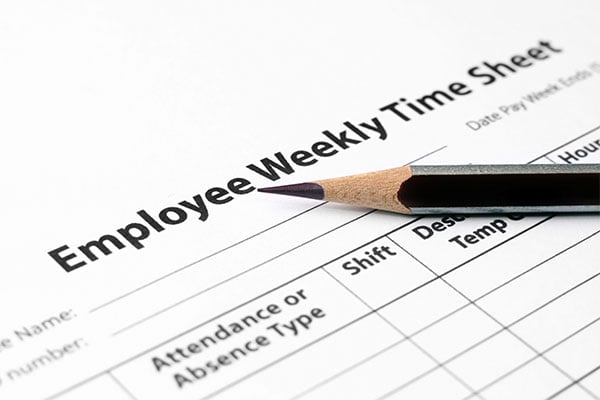
Efficient scheduling is the backbone of a successful restaurant. From ensuring adequate coverage during peak hours to balancing staff needs and operational costs, crafting a well-thought-out schedule is both an art and a science. Creating an effective schedule comes with challenges, as managers must juggle employee availability, labor laws, unpredictable customer demand, and the ever-present risk of burnout. To aid in your restaurant scheduling efforts, we've created a guide that covers the key considerations, tools, and techniques that will make restaurant scheduling easier and more effective.
How to Design Restaurant Shifts
Effective restaurant scheduling requires balancing operational needs with employee satisfaction, all while ensuring customer demand is met. Below we've outlined a step-by-step guide to designing restaurant shifts that work:1. Determine the Number of People Needed

The foundation of an efficient shift schedule is understanding the required staffing levels. Begin by analyzing historical sales data and customer flow to estimate the number of employees needed in various roles. Account for different times of day and unique needs, such as additional dishwashers during busy dinner services or extra hosts during brunch.
2. Decide on a Shift Structure
Select the shift structure that aligns best with your restaurant’s operations. Common options include split shifts, rotating shifts, fixed shifts, and on-call shifts. Choose a structure that supports your restaurant’s demand patterns while considering employee preferences and legal regulations.
- Split Shifts - Employees work two separate shifts in one day with a long break in between, commonly used in restaurants with busy lunch and dinner rushes.
- Rotating Shifts - Employees cycle through different shift times (morning, afternoon, night) on a set schedule to ensure fair distribution of work.
- Fixed Shifts - Employees work the same scheduled hours consistently, providing stability for both staff and management.
- On-Call Shifts - Employees are scheduled as backups and must be available to work if needed, helping cover unexpected absences or busy periods.
3. Identify Peak Traffic Hours
Use tools like POS systems, reservation platforms, or manual tracking to pinpoint high-traffic periods. For example, Saturday evenings or weekday lunch hours might consistently see heavy foot traffic. By identifying these peaks, you can allocate more staff during critical times to maintain service quality.
4. Plan for Seasonal Traffic
Seasonality can significantly impact restaurant traffic. Holidays, local events, and tourist seasons often increase customer demand, while slower periods may require scaling back. To plan effectively, review past performance data to identify seasonal patterns, and consider hiring temporary workers or offering flexible schedules to accommodate surges. By proactively planning for these fluctuations, you can ensure smooth operations year-round while avoiding overstaffing or understaffing.
How to Schedule Restaurant Shifts

A well-thought-out shift schedule benefits the restaurant and its employees, ensuring efficiency and satisfaction on all fronts. Properly understanding how to schedule restaurant shifts will keep employees engaged, helping to boost job satisfaction and reducing turnover.
- Vary Shift Times - Ensure employees are scheduled for different shifts to avoid burnout and monotony. Rotating workers between morning, afternoon, and evening shifts allows them to gain experience in various tasks and maintain fairness.
- Schedule the Appropriate Amount of People - Anticipate busy periods and plan accordingly. Use past sales data to predict when more staff will be needed, such as during weekends, holidays, or promotions. Avoid overstaffing during slower periods to keep labor costs in check.
- Keep Some Workers on Call - Unpredictable rushes or last-minute call-outs can disrupt the flow. Having a few employees on call ensures you can adapt quickly to sudden changes. Communicate clearly with on-call staff about their potential responsibilities and provide ample notice when possible.
- Consider Employees’ Personal Lives - A good schedule accommodates employees’ personal commitments, such as childcare, school, or other jobs. Gathering availability ahead of time and being flexible fosters a positive work environment, boosting morale and retention.
- Give Employees Enough Time to Rest - Avoid scheduling employees for back-to-back closing and opening shifts. Adequate rest between shifts improves performance and prevents exhaustion, leading to a healthier and more productive team.
Restaurant Schedule Considerations

Effective scheduling in a restaurant involves balancing operational needs with compliance and fairness. By considering the factors below when constructing your restaurant schedule, you can create a schedule that balances employee satisfaction, legal requirements, and operational efficiency.
- Overtime - Be mindful of overtime rules to manage labor costs and avoid burnout. Ensure employees working over 40 hours a week (or as defined by local laws) are compensated fairly. Proactively monitor hours to prevent unnecessary overtime, but also use it strategically during peak periods when extra coverage is needed.
- Tipping - Consider how tipping practices may impact scheduling. Servers and bartenders often rely on tips for income, so assigning them to shifts with high customer traffic can boost their earnings. At the same time, distribute lucrative shifts equitably among staff to maintain fairness and morale.
- Work Scheduling Laws for Minors - If you employ minors like teenagers or high school students, familiarize yourself with applicable labor laws, such as limits on working hours during school days and mandatory breaks. Scheduling minors in compliance with these rules is not only a legal requirement but also supports their academic and personal responsibilities.
- Full-Time Equivalent (FTE) - Understand the concept of full-time equivalent employees to plan your workforce efficiently. This measure calculates the number of full-time workers based on total labor hours worked. Properly balancing full-time and part-time staff ensures operational flexibility while managing benefits and compliance costs effectively.
Posting a Restaurant Schedule
Post the schedule at least one to two weeks in advance. This provides employees enough time to plan their personal lives, request changes, or address any conflicts. Consistency is key, so you need to set a regular day for releasing schedules, such as every Sunday for the upcoming week. To make it easy to access for employees, you'll want to place the schedule in a common area like a breakroom or kitchen, or use digital tools like scheduling apps, email, or a shared cloud document to make the schedule accessible from anywhere.
Once the schedule is posted, send notifications through email, text, or scheduling software to ensure all employees are aware. Create a clear process for employees to report conflicts, request changes, or swap shifts. Open lines of communication foster trust and make it easier to address scheduling challenges. If adjustments to the schedule are needed, notify affected employees immediately and confirm their availability. Keep all versions of the schedule up to date to avoid confusion.
Restaurant Scheduling Software
For new businesses or schedulers, software can be a massive timesaver. There are several places you can find software, so take some time to shop around and pick what works best for your needs. Some programs are designed to work with any foodservice setup. Meanwhile, other programs are made for specific demographics, like independent restaurateurs.
There's no universal "right" answer when it comes to making a schedule, as you need to choose a schedule that aligns with your restaurant's needs and resources. Below, we've outlined some of the major benefits your establishment may be able to reap should you implement restaurant scheduling software into your business:
- Efficiency and Time Savings - Scheduling software automates time-consuming tasks such as calculating labor hours, assigning shifts, and tracking availability. This allows managers to focus on other critical aspects of running the restaurant.
- Improved Communication - Many platforms provide real-time communication features, allowing employees to view schedules, request changes, and swap shifts directly through the software. This reduces miscommunication and ensures everyone is on the same page.
- Adaptability to Changes - With dynamic scheduling tools, adjustments can be made quickly in response to last-minute call-outs, peak periods, or unexpected surges in business. Managers can easily reassign shifts or notify on-call staff as needed.
- Compliance Management - Scheduling software helps ensure compliance with labor laws, such as tracking overtime, managing minors' schedules, and maintaining proper rest periods. It can also flag potential conflicts before they become issues.
- Data Insights - Many programs provide analytics to help managers understand labor costs, peak hours, and employee performance. These insights enable better decision-making when planning shifts and allocating resources.
Restaurant scheduling may seem overwhelming at first, but just remember that this process doesn’t always have to be overly complicated. The best way to avoid headaches around your staff’s schedule is to create a culture of accountability in your restaurant. By earning the trust and respect of your employees, you can create a motivated work environment where your staff will want to show up on time. Building a trusted team of reliable employees is the best thing you can do to alleviate stress when schedule time comes around. Combine your staff’s accountability with scheduling software and other systems to keep you organized, creating an efficient and effective restaurant schedule for your establishment.





